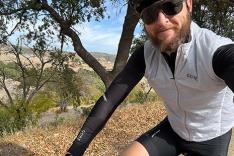If your club has these kinds of bikes with the weighted flywheels, here is a test you can do that will highlight this point (Startrac Spinners or Schwinn bicycles older than a year or two are two common manufacturers of these bikes, though your club may have another brand with similar characteristics):
Stand next to the bike and turn the resistance knob all the way to the left so there is no resistance. Now grab the pedal and turn it very quickly for about seven or eight good solid turns until the pedals and flywheel are spinning at well over 100 rpm (use caution that you don't get your finger caught in the pedal axel and stay out of the way of the moving pedal because if it hits you it will not stop). Now wait. You will see that it will take a long time, a very log time, before it slows down! This is because of the inertia in the weighted flywheel—it assists in the momentum of the drivetrain.
Because of this, all those unskilled riders pedaling at high cadences with no or insufficient resistance, bouncing all over the saddle, are basically strapped on to those pedals for the ride. They don't have to do much work to keep them spinning at high cadences when the brake is not touching the flywheel. In a way, they are being ridden by the bike, instead of riding the bike. Without resistance, they will not achieve some of the fantastic benefits that indoor cycling provides. Because their heart rates may still be high, they interpret it as "work" and believe the calories burned number their heart rate monitors give them.
Sadly, this is not the case, and may very well be the reason why some people do not see the results they could be seeing in indoor cycling classes. It's important to remember that heart rate is not always an effective indicator of how much work you are doing. Power measurement is much better. I know that power meters are still not very prevalent in fitness clubs, but that is slowly and surely changing as more and more adopt bikes with measurement tools.
The answer to success lies in that resistance knob!
How it Translates Outdoors
There is proof, if only I had the opportunity to show it to these riders and instructors. If they had a power meter on the bike, they would see that pedaling at high cadences and very low or no resistance actually produces a low power output. Heart rates are high because of the lack of technique, the bouncing and flopping in the saddle and the general inability to contract their muscles quickly.
Poor technique is costly in terms of calories, yet those calories don't translate to strength, fitness, muscular endurance or aerobic endurance benefits. It would be much better to channel the effort into a higher power output by raising the resistance and slowing the legs down. As mentioned earlier, power translates directly into calories burned; heart rate is only an indirect (and often incorrect) indication of how many calories are burned in an exercise session.
The next litmus test would be to put them on a road or mountain bike and ask them to pedal at 120-140 rpm and sustain it. Very few people, except the most skilled cyclists, could do that for very long outdoors, although it's somewhat easy to maintain indoors when there's no resistance. In order to do this on a flat road, most would have to be in a granny gear. Pedaling at 120-plus rpm in that granny gear, their speed would be so slow that a child on a tricycle could probably pass them.
Again, their heart rates would likely be high, but the lack of speed would be blatant proof that they are doing very little actual "work". Outdoors, when your feet are flailing but you aren't moving forward quickly, it's a sign that you need to increase the gear. When you do, your cadence will slow down to (most likely) less than 100 rpm but you will go faster. This means your power output is higher. Indoors, we don't have the benefit of forward movement—or lack of it, to show the rider that excessive cadences and no resistance translate to little actual work.
- 2
- of
- 3
About the Author









Discuss This Article